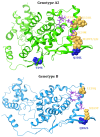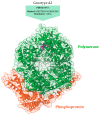Insights into the Currently Available Drugs and Investigational Compounds Against RSV with a Focus on Their Drug-Resistance Profiles
- PMID: 40573384
- PMCID: PMC12197531
- DOI: 10.3390/v17060793
Insights into the Currently Available Drugs and Investigational Compounds Against RSV with a Focus on Their Drug-Resistance Profiles
Abstract
Respiratory syncytial virus (RSV) is a leading cause of severe respiratory illness in infants, young children, as well as elderly and immunocompromised patients worldwide. RSV is classified into two major subtypes, RSV-A and RSV-B, and remains the most frequently detected pathogen in infants hospitalized with acute respiratory infections. Recent advances have brought both passive and active immunization strategies, including FDA-approved vaccines for older adults and pregnant women and new monoclonal antibodies (mAbs) for infant protection. Although significant progress has been made, the need remains for improved antiviral treatments, particularly for vulnerable infants and immunocompromised patients. Recent studies have identified multiple RSV mutations that confer resistance to current treatments. These mutations, detected in both in vitro studies and clinical isolates, often complicate therapeutic outcomes, underscoring the need for updated and effective management strategies. In this context, evaluating protein flexibility through tools like DisoMine provides insight into how specific mutations impact structural dynamics at binding sites, thus affecting ligand affinity. This review aims to synthesize these aspects, offering a comprehensive insight into ongoing efforts to counteract RSV and address the evolving challenge of drug resistance.
Keywords: RSV; drug resistance; mutations; novel drugs; structural dynamics.
Conflict of interest statement
The authors declare no conflicts of interest.
Figures









References
-
- Li Y., Wang X., Blau D.M., Caballero M.T., Feikin D.R., Gill C.J., Madhi S.A., Omer S.B., Simões E.A.F., Campbell H., et al. Global, regional, and national disease burden estimates of acute lower respiratory infections due to respiratory syncytial virus in children younger than 5 years in 2019: A systematic analysis. Lancet. 2022;399:2047–2064. doi: 10.1016/S0140-6736(22)00478-0. - DOI - PMC - PubMed
Publication types
MeSH terms
Substances
LinkOut - more resources
Full Text Sources
Medical

